11.0 INTRODUCTION
CONCEPT OF TEMPERATURE: Temperature is a measure of the average kinetic energy of the particles in a substance. It indicates the hotness or coldness of an object.
TEMPERATURE UNITS: Commonly measured in degrees Celsius (°C), Kelvin (K), and Fahrenheit (°F).
11.1 THERMOMETRIC AND EFFECTS
THERMOMETRIC PROPERTIES
- Thermal Expansion: Many substances expand when heated and contract when cooled. This property is utilized in liquid-in-glass thermometers.
- Electrical Resistance: Some materials change their electrical resistance with temperature, which is used in resistance temperature detectors (RTDs).
THERMOELECTRIC EFFECT: The Seebeck effect is used in thermocouples, where a voltage is generated in response to a temperature difference.
11.2 CALIBRATION OF THERMOMETERS
Calibration of thermometers is the process of adjusting the thermometer to ensure accurate readings.
METHODS OF CALIBRATION OF THERMOMETERS
- By using fixed points (like the freezing and boiling points of water) to set the scale.
- Standard Reference Points: For Celsius, 0°C is the freezing point of water, and 100°C is the boiling point at standard atmospheric pressure.
- TEMPERATURE SCALE
TYPES OF TEMPERATURE SCALES
- Celsius Scale: Based on the freezing (0°C) and boiling (100°C) points of water. It is widely used in everyday applications.
- Kelvin Scale: Absolute temperature scale starting at absolute zero (0 K), where all molecular motion stops. The relationship is between Celsius scale and Kelvin scale is given by: K = °C + 273.
- Fahrenheit Scale: The Fahrenheit scale measures temperature; water freezes at 32°F and boils at 212°F under standard conditions, mainly used in the US.
CONVERSION BETWEEN TEMPERATURE SCALES
- Celsius to Kelvin: K = °C + 273
- Kelvin to Celsius: °C = K – 273
- Celsius to Fahrenheit: °F = (°C × 9/5) + 32
- Fahrenheit to Celsius: °C = (°F – 32) × 5/9
11.4 TYPES OF THERMOMETERS
- Liquid-in-Glass Thermometers: Use liquids (like mercury or alcohol) that expand and contract with temperature changes.
- Digital Thermometers: Use electronic sensors to measure temperature and display it digitally.
- Infrared Thermometers: Measure the infrared radiation emitted by an object to determine its temperature without contact.
- Thermocouples: Use the voltage generated at the junction of two different metals to measure temperature.
- THERMAL EXPANSION
Thermal expansion refers to the increase in size (length, area, or volume) of a material when it is heated. This occurs because the particles in the material move more vigorously and tend to occupy more space.
LINEAR EXPANSIVITY: Linear expansion is the change in length of a solid when its temperature changes.
Linear expansivity of a substance is defined as the fractional increase in length per unit length per degree rise in temperature.
Linear Expansivity is given by:
ΔL = α * L₀ * ΔT
Where ΔL is the change in length,
α is the coefficient of linear expansion,
L₀ is the original length, and
ΔT is the change in temperature.
AREA EXPANSIVITY: Area expansion is the change in area of a solid when its temperature changes.
It is defined as the fractional increase in area per unit area per degree rise in temperature.
Area expansivity is given by:
ΔA = 2α * A₀ * ΔT
Where ΔA is the change in area,
A₀ is the original area.
CUBIC EXPANSIVITY: Cubic expansivity is the change in volume of a solid or liquid when its temperature changes.
It is defined as the fractional increase in volume per unit volume per degree rise in temperature.
Cubic Expansivity is given by:
ΔV = β * V₀ * ΔT
Where ΔV is the change in volume,
β is the coefficient of volume expansion,
V₀ is the original volume.
RELATIONSHIP BETWEEN DIFFERENT EXPANSIVITIES
The relationship between these expansivities is based on the number of dimensions involved:
- Area expansivity is twice linear expansivity i.e., β=2a
- Cubic expansivity is three times area expansivity i.e., Y=3a
EFFECTS AND APPLICATIONS OF THERMAL EXPANSION
- Building Strips: In construction, materials expand and contract with temperature changes. Expansion joints are used in buildings and bridges to accommodate this movement.
- Railway Lines: Gaps are left between railway tracks to allow for expansion during hot weather, preventing buckling.
- THERMAL EXPANSION IN LIQUIDS
VOLUME EXPANSIVITY: Liquids expand in volume when heated, and this is characterized by the coefficient of volume expansion (β).
REAL AND APPARENT EXPANSIVITIES: Real expansivity refers to the actual change in volume, while apparent expansivity considers the effects of temperature changes in the container as well.
DETERMINATION OF VOLUME EXPANSIVITY: Volume expansivity can be determined experimentally by measuring the change in volume of a liquid with temperature.
- ANOMALOUS EXPANSION OF WATER
Water exhibits anomalous expansion, meaning it expands when cooled from 4°C to 0°C. This is why ice floats on water.
11.8 MODES OF HEAT TRANSFER
- Conduction: The transfer of heat through a material without the movement of the material itself. Metals are good conductors.
- Convection: The transfer of heat by the movement of fluids (liquids and gases). Hot fluid rises while cooler fluid sinks, creating a convection current.
- Land and Sea Breeze: Land breezes occur at night when land cools faster than water, causing cooler air to flow from land to sea.
Sea breezes occur during the day when land heats up faster than water, causing cooler air to flow from sea to land.
- Radiation: The transfer of heat through electromagnetic waves. All objects emit radiation, and this is how heat can be transferred through a vacuum.
11.9 CONCEPT OF THERMAL CONDUCTIVITY
Thermal Conductivity (k) is defined as a measure of a material’s ability to conduct heat. It is defined as the amount of heat that passes through a unit area of the material in a unit time for a temperature difference.
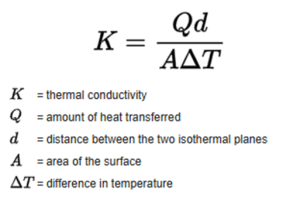
It is given by the formula:
CONCEPT OF HEAT FLUX (q) – The rate of heat transfer per unit area, expressed as q = Q/A. It is influenced by the thermal conductivity and the temperature gradient.
11.10 EFFECTS OF THE NATURE OF THE SURFACE ON ENERGY RADIATED AND ABSORBED
- The nature of a surface affects its emissivity, which is the ability to emit and absorb thermal radiation.
- Darker and rougher surfaces tend to absorb and emit more energy than lighter and smoother surfaces.
- Black bodies are ideal emitters and absorbers of radiation, while shiny surfaces reflect more energy.
11.11 CONDUCTIVITIES OF COMMON MATERIALS
- Metals (e.g., copper, aluminum) have high thermal conductivity.
- Wood and plastics have moderate thermal conductivity.
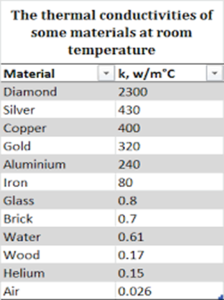
Insulating materials (e.g., glass wool, Styrofoam) have low thermal conductivity.
CONCEPT OF THERMOS FLASK
A thermos flask is designed to keep liquids hot or cold by minimizing heat transfer.
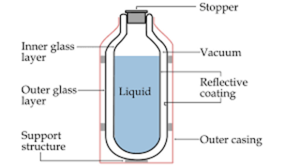
It consists of two walls with a vacuum in between, which reduces conduction and convection. The inner surface is often reflective to minimize heat loss through radiation.
DTW Tutorials Study Resource Links;
First of All to obtain high JAMB &WAEC Scores, YOU HAVE TO Practice! Practice!! Practice!!
Use DTW JAMB & WAEC 2025 CBT Practice App!!!
– GET DTW TUTORIALS JAMB & WAEC 2025 CBT EXAM PRACTICE APP for all Subjects with over 31,000 Past Questions and Correct Solutions to Practice with offline! (Activation cost is N4000 for 1 year) Download Links Below for Mobile Phones & Laptop Computer;
DTW TUTORIALS JAMB 2025 APP For MOBILE Phone Direct Download link;
https://play.google.com/store/apps/details?id=com.iafsawii.dtw.jamb
DTW TUTORIALS JAMB 2025 APP For DESKTOP Laptop Computer Direct Download link; https://drive.google.com/file/d/1iIHBoWjEeJeCFyTO9nt-9kAveH2FqjrT/view?usp=sharing
Download Links for WAEC 2025 App;
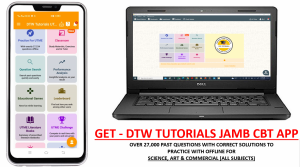
JAMB RESOURCE LINKS BELOW;
– JAMB Past Questions Solved Playlists on Math, Phy, Chem; https://www.youtube.com/playlist?list=PLLgYU6fS5143-p4dfWIFL7keuB1SBgT2b
– THE LEKKI HEADMASTER – Summary, Questions And Answers (JAMB 2025 NOVEL); https://dtwtutorials.com/the-lekki-headmaster-jamb-2025-novel-summary-questions-and-answers-pdf-download/
– JAMB 2025 Recommended Text Books – https://dtwtutorials.com/jamb-2025-recommended-text-books-for-all-subjects/
– JAMB 2025 Syllabus all Subjects – https://dtwtutorials.com/jamb-2025-syllabus-free-download/
– JAMB 2025 Syllabus in 30 Days Timetable Challenge by DTW Tutorials for Science, Art & Commercial Subject Combinations – Cover Your JAMB Syllabus in 30 Days Challenge; https://dtwtutorials.com/jamb-2025-syllabus-in-30-days-timetable-challenge-by-dtw-tutorials-cover-your-jamb-syllabus-in-30-days-challenge/
– How to Manage Your Jamb Exam Time for High Scores; https://youtu.be/Tp4Va8haib8
– Physics Notes and Questions on All topics; https://dtwtutorials.com/category/tutorials/physics-tutorials/
– Chemistry Notes and Questions on All topics; https://dtwtutorials.com/category/tutorials/chemistry/
– How to Read, Understand and Remember Always- https://youtu.be/kL8BpRePudA
– How to Cover Your JAMB Syllabus Fast in 30 Days!!; https://youtu.be/RVgyn01Ptd0
– What to do a night before your Jamb Exam (+Exam Prayers); https://youtu.be/njbAx4Oz5Rw
– How to Manage Your Jamb Exam Time for High Scores; https://youtu.be/Tp4Va8haib8
– Overcoming Exam Fear/Anxiety– https://youtu.be/Uvf81rvd0ls
You can also join our online groups below for instant JAMB 2025 Updates;
Join DTW JAMB 2025 Intensive Tutorials Study Groups on Facebook, Telegram and WhatsApp Group;
Facebook Group – https://web.facebook.com/groups/dtwtutorialsgroup/
WhatsApp Group – https://chat.whatsapp.com/E8pprCQYtahKfpQN9UB0aU
Telegram Group – https://t.me/+AcXfhJPSIiI2ZTY0
WhatsApp Channel – https://whatsapp.com/channel/0029VaAWvTmDDmFT9o25dV3u
DTW JAMB 2025 Intensive Online Lessons/Tutorials
Online JAMB 2025 Tutorials – Your Path to Jamb Success!
Are you preparing for the JAMB 2025 Exam and aiming for excellence? Look no further than Online Jamb Tutorial by DTW Consult. We’re dedicated to helping you ace your Jamb with confidence.
- Why Choose DTW Online JAMB Intensive Tutorials?
• Engaging, Clear and Interactive Online Lectures
• Completion of JAMB Syllabus
• Weekly Quiz Assessments
• Continuous Brainstorming and Competitions
• Membership in an Active Learning Community
• Consistent Solving of JAMB Past Questions-
• Expert Jamb Instructors
• Comprehensive Study Materials - All Classes are Recorded!! In case you miss any class, and when you join us you will have access to all the previous class recorded videos!!!
• Subjects;
English
Physics
Chemistry
Biology
Math
Economics
Literature
Crs
Government
• Affordable Tuition – N7000 monthly (6pm – 10pm, Mon to Fri)
Lectures Ongoing! Register Now!!
Bank Details:
Account Name: DTW Consult
Account Number: 6414330770
Bank: Moniepoint
Amount – N7000
For easy payment and enrollment.
Proof of payment should be sent by WhatsApp.
Contact Us:
WhatsApp: 09085099582, 08038732879
Email: dtwconsultng@gmail.com
Take a step closer to your Jamb success with DTW Online Jamb 2025 Intensive Tutorials.
Let’s work together to unlock your full potential!
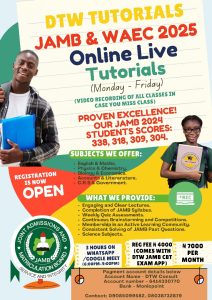
https://youtu.be/P7wtBH46ZMMnsive Tutorials. Let’s work together to unlock your full potential! #JambPrep #OnlineTutorial #DTWConsult #JambSuccess #jamb2025 #utme2025

No Comments